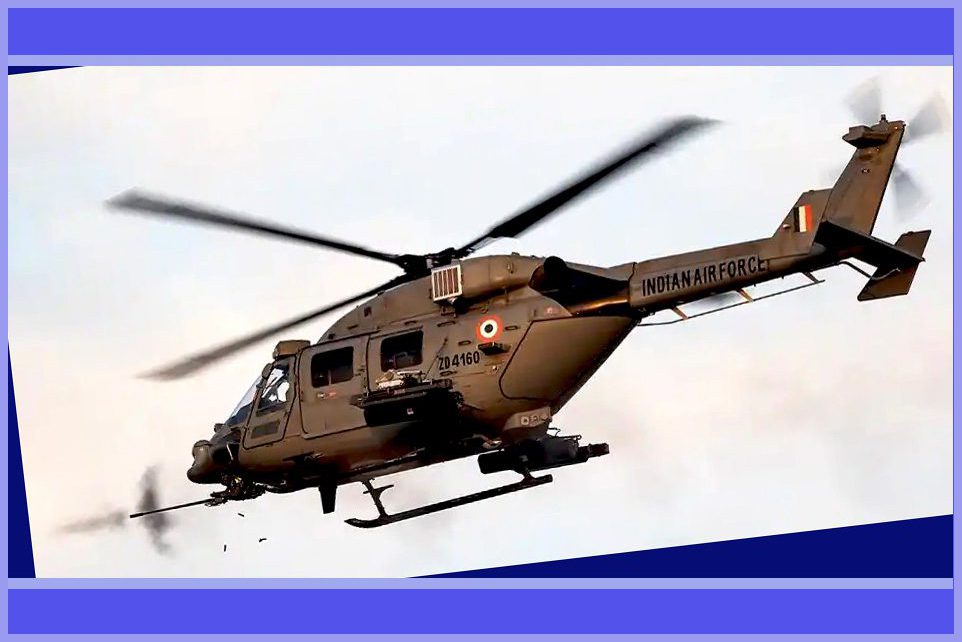The HAL Dhruv, developed by Hindustan Aeronautics Limited (HAL), stands as a versatile and indigenous multi-role utility helicopter that has earned the status of a flagship aircraft in both the Indian military and civilian sectors. The transformation from HAL Dhruv to Rudra signifies a transition from utility to a military helicopter. Tailored to excel in a wide array of missions, this helicopter took its inaugural flight in 1992. The Dhruv distinguishes itself with its exceptional agility, reliability, and performance.
This medium-sized, twin-engine helicopter boasts a spacious cabin capable of accommodating up to 12 passengers or being configured to meet various mission-specific equipment requirements.
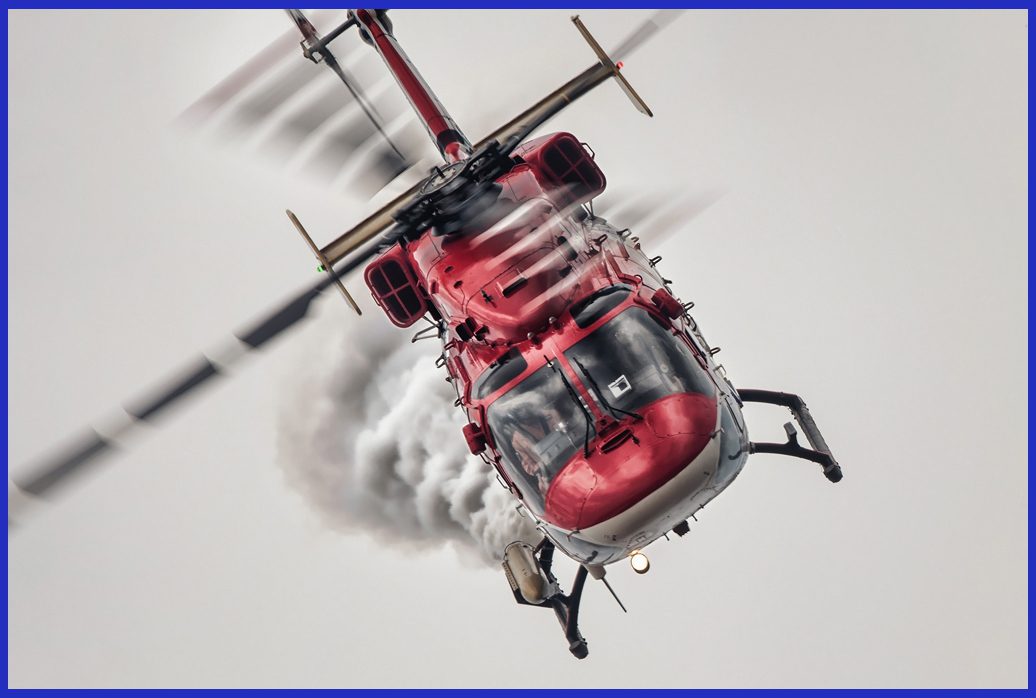
Equipped with state-of-the-art avionics and navigation systems, it excels in roles such as troop transport, search and rescue, medical evacuation, cargo transport, and reconnaissance. This aircraft signifies a significant advancement that greatly aids our soldiers during wartime and in handling challenging situations involving terrorists. It functions as a network-centric, fully integrated weapon system.
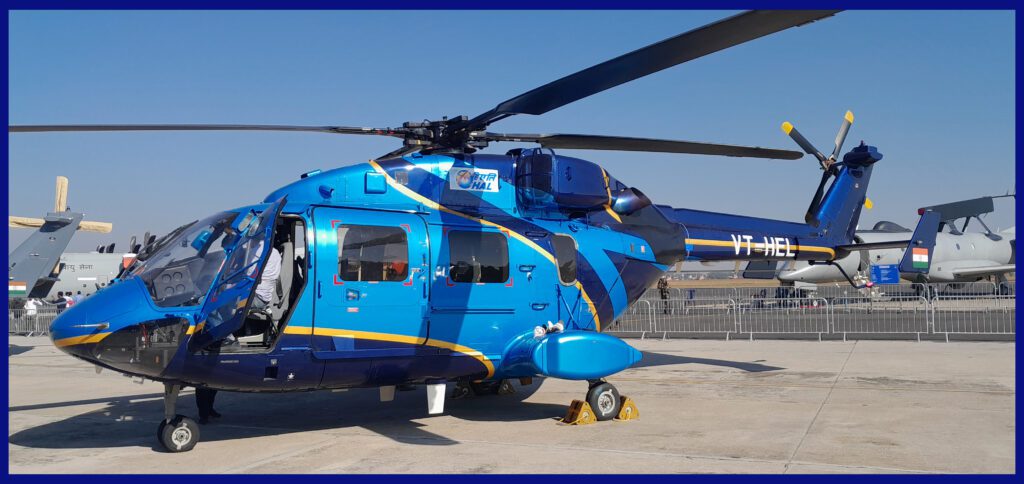
Transport, utility, reconnaissance and medical evacuation variants are among the military versions now in development. A total of 340 HAL Dhruvs have been produced as of January 2023, accumulating more than 344,000 flight hours for domestic and international markets.
Background About HAL Dhruv Helicopter
The Indian Air Force and Indian Navy Air Arm launched the Advanced Light Helicopter (ALH) program in May 1979 with the goal of developing a 5-ton indigenous multirole helicopter. In 1984, the Indian government awarded HAL a contract to manufacture the helicopter.
The concept of the Advanced Light Helicopter (ALH) was first envisioned, with the then-Indian Vice President K R Narayanan in attendance. ALH successfully completed its inaugural flight on August 20, 1992, departing from Bangalore. Subsequently, on April 18, 1993, a navalized prototype equipped with Allied Signal CTS800 (German) engines and a retractable tricycle undercarriage was introduced. This milestone was followed by the development of a second prototype, specifically designed for the Army and Air Force.
Subsequently, sanctions were imposed on India following a series of Pokhran-II nuclear tests in 1998 and India’s ongoing refusal to sign the CTBT. Consequently, the French company Turbomeca TM 333-2B2 turboshaft engine was selected as a replacement. Turbomeca also agreed to collaborate with HAL to develop a more powerful engine, formerly known as the Ardiden. Additionally, Turbomeca played a role in the helicopter’s development, with French researchers conducting rotor mechanics and stress analysis. On August 16th, 2007, Dhruv conducted its inaugural flight using the new Shakti engine variant.

In January 2002, deliveries of the Dhruv commenced, marking nine years since the prototype’s inaugural flight. The Indian Coast Guard was the first to operate the Dhruv, followed by the Indian Army, Indian Navy, Indian Air Force, and Border Security Force. By 2007, a total of 75 Dhruvs had been delivered to the Indian armed forces, with plans to produce 40 helicopters annually starting in 2008. The Indian Air Force’s Sarang aerobatic display team performed using 4 Dhruv helicopters. Additionally, in 2007, the Indian Army placed an additional order for 166 helicopters.
Civil variants of the Dhruv are manufactured to serve various purposes including transport, rescue, policing, offshore operations, air ambulance, and other roles. The Dhruv’s power comes from its Shakti (Turbomeca TM 333-2B2) turboshaft engines, ensuring high altitude and hot-weather performance. It also incorporates state-of-the-art safety features and is known for its ability to operate in challenging environments, including high-altitude regions and maritime conditions. With its successful track record in both military and civilian applications, the HAL Dhruv has proven itself as a reliable and adaptable helicopter in India’s aerospace industry.

The Transformation From HAL Dhruv to Rudra
Rudra is the weaponized version of the Advanced Light Helicopter (Dhruv), which was designed and developed by Hindustan Aeronautics Limited (HAL) to fulfil the requirements of the Indian Army and Air Force. This multi-role helicopter, belonging to the 5.8-ton class, is powered by two Shakti Engines. Referred to as the ALH-WSI (Advanced Light Helicopter – Weapon System Integrated), the HAL Rudra is a dedicated armed helicopter. The development of the Rudra occurred concurrently with that of the HAL Light Combat Helicopter (LCH), an attack helicopter derived from the Dhruv platform.
The advanced armed helicopter is outfitted with a range of sophisticated equipment, including a forward-looking infrared (FLIR) camera, day-and-night optical cameras, and a Thermal Imaging Sights Interface. Furthermore, it is armed with a potent 20 mm turret gun, versatile 70 mm rocket pods, highly effective anti-tank guided missiles, and precise air-to-air missiles. The prototype of the Rudra embarked on its maiden flight on August 16, 2007, marking a significant milestone in a project that had been initiated in December 1998.
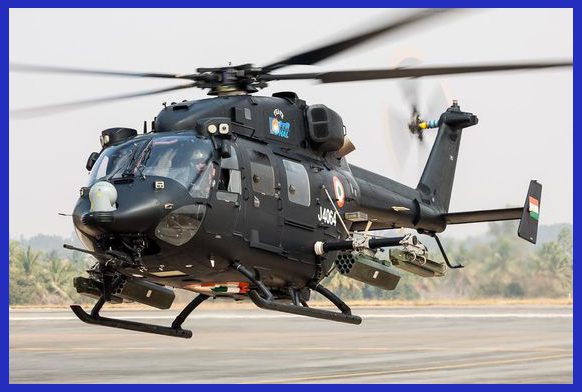
Between 2011 and 2013, an extensive phase of flight testing for the Rudra took place, during which it not only met but often exceeded the predefined requirements. On February 4, 2013, at the Aero India trade show, it was officially announced that the HAL Rudra Mk IV had achieved Initial Operational Clearance (IOC), signifying its readiness for active service. Subsequently, a pair of these advanced helicopters was delivered to the Indian Army.
However, the Indian Army has continued to receive Rudra helicopters, and as of 2023, there are currently 80 helicopters in active service, with an additional 20 on order. In addition to the Army, the Indian Air Force also has 16 Rudra helicopters in service, with an order for 50 more in progress. This highlights the ongoing deployment and expansion of this versatile armed helicopter in India’s defence forces.
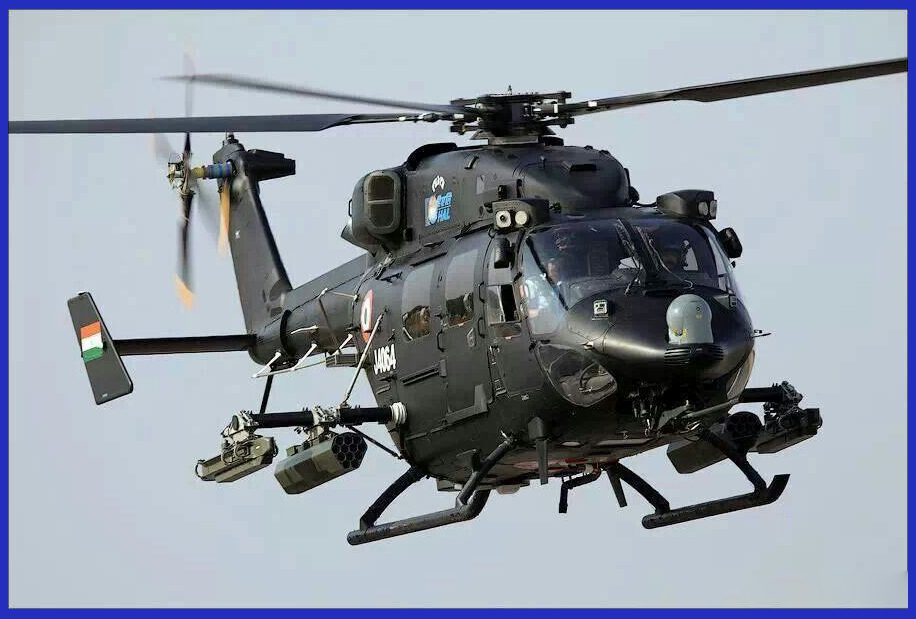
This twin-engine helicopter is designed to operate in diverse conditions, from high-altitude regions to hot and humid climates. Its versatility and firepower make it a valuable asset for the Indian armed forces, capable of performing roles such as close air support, troop insertion, and reconnaissance. The HAL Rudra represents a significant enhancement to India’s military helicopter capabilities.
Roles Assigned For Rudra:
- Anti-tank
- Scout
- Fire support
- Armed reconnaissance and surveillance
- Escort
- EW platform
Salient Features:
- Excellent hover performance
- Designed for the high rate of climb performance
- Sufficient safety margins are incorporated to account for the possibility of a single-engine failure.
- Well-suited for operations conducted from unprepared surfaces and sloped terrain.
- Engineered to excel in cost-effective operations, thanks to enhanced fuel efficiency and reduced maintenance expenses.
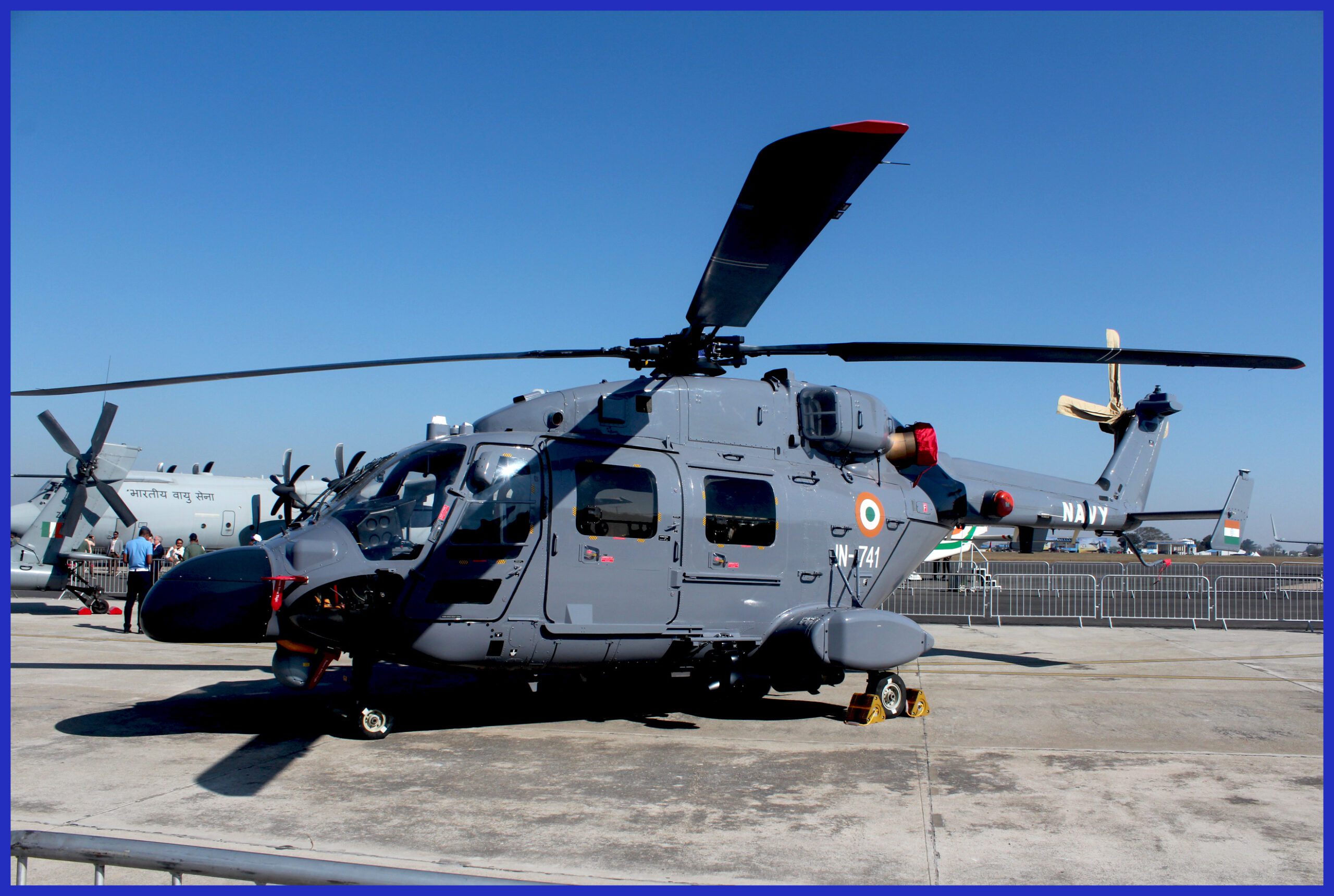
Mission Sensors:
- Electronic Warfare (EW) Suite
- Helmet Pointing System (HPS)
- Electro-Optical (EO)-Pod.
- Video and Data Recorder (VDR)
- Flare and Chaff Dispenser (FCD)
Within the timeframe of 2012 to 2013, the Rudra successfully conducted a comprehensive series of flight tests specifically for the Indian Navy. The results of these tests revealed that the helicopter possessed the ideal attributes for effectively carrying out coastal surveillance operations. Particularly noteworthy was the Rudra’s sensors’ exceptional capability to track ships at distances of up to 14 kilometres, an accomplishment that left the naval service thoroughly impressed.
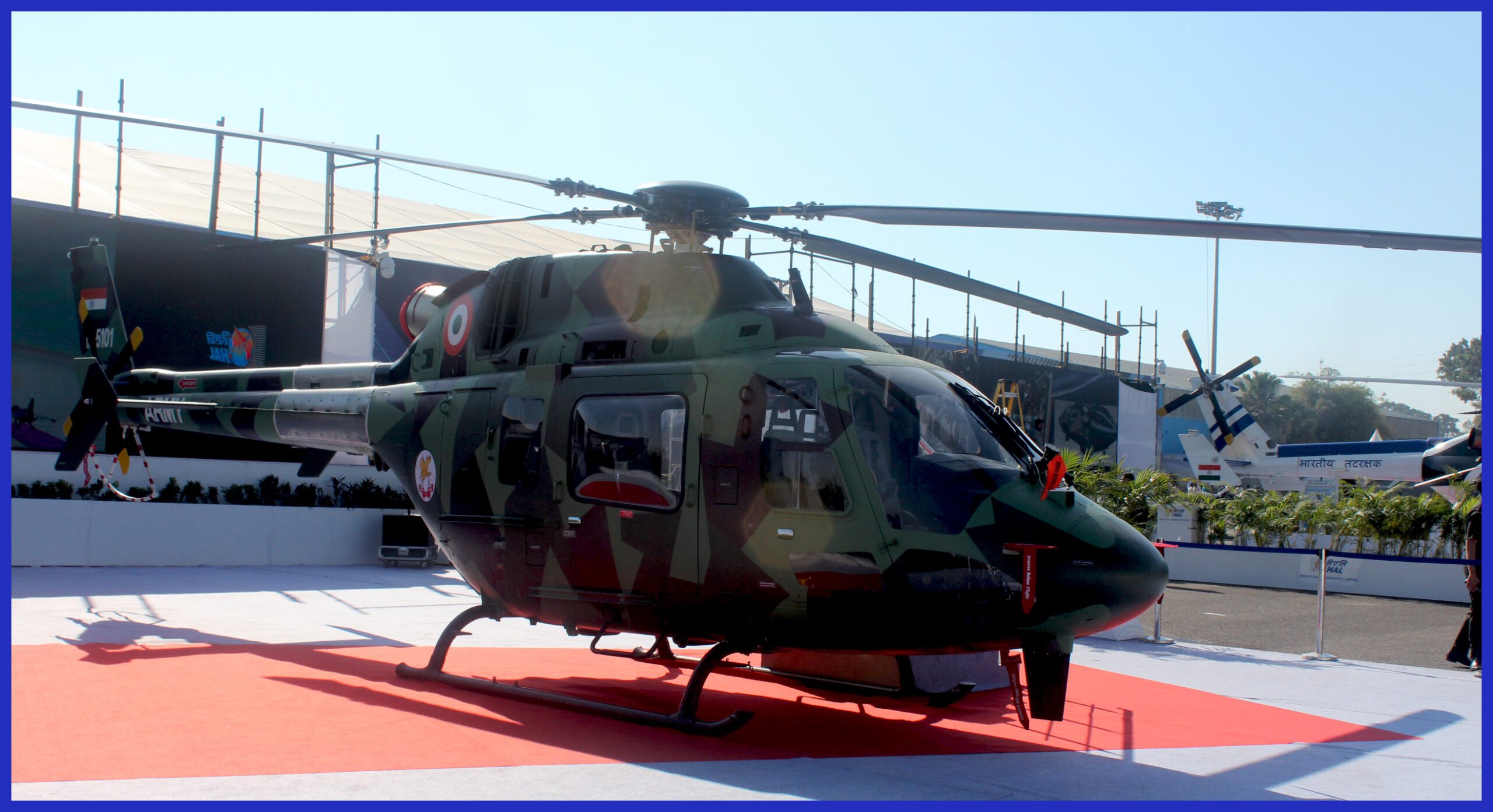
Such high image quality of the sensors was reported that they could even discern and read the names of ships at those considerable ranges. Consequently, the Indian Navy expressed a keen interest in procuring a minimum of 20 Rudra helicopters to enhance its own operational capabilities.
Before embarking on the series of tests mentioned earlier, the Rudra had previously undergone thorough evaluations in the domain of anti-submarine warfare (ASW). Moreover, as part of the armament tests, the helicopter successfully conducted test firings involving both torpedoes and depth charges. These achievements in armament testing added to the helicopter’s overall capabilities and readiness for various mission scenarios.

Specifications of HAL Dhruv / Rudra Helicopter
- Crew: 2 ( pilot & co-pilot gunner)
- Capacity: 12 Troops
- Length: 52 ft ( 15.87 m )
- Width: 10 ft 4 in ( 3.15 m )
- Height: 16 ft 4 in ( 4.98 m )
- Gross Weight: 4,445 kg ( 9,800 lb )
- Max takeoff weight: 5,800 kg ( 12,787 lb ) for Mk IV
- Combat Mission Speed: 280 km/h
- Range: Rudra _ 590 km and Dhruv _ 630 km for Mk III
- Combat Endurance: 3.8 hours
- Service Ceiling: 20,000 ft ( 6,100 m )
- Rate of climb: 2,033 ft / m ( 10.33 m/s )
- Powerplant: 2 x HAL Turbomeca Shakti-1H turboshaft, 1,068 kW ( 1,432 hp each )
- Armament: One French Origin, 20 mm M621 cannon
- Total of 4 Hard Points: With provisions to carry combinations of _
- Rockets: 4 x 12 FZ275 laser Guided Rocket ( LGR ) Or Missiles: 4 x 2 Mistral ( AAM ) Or 4 x 4 Helina ( Anti-tank Guided Missile ) Or Combinations of Precision guided munition, cluster munition, Granade launcher, Unguided bombs.

Moreover, don’t miss the chance to own an exquisite scale model of the Su-30 fighter jet, conveniently available on Amazon and Air Models. Just click the provided links to access this remarkable aircraft. Known for its devastating capabilities in combat, it showcases the Russian military’s commitment to advanced technology and precision warfare.

In conclusion, the HAL Rudra stands as a testament to India’s commitment to advancing its military capabilities and strengthening its defence infrastructure. As a specialized armed helicopter derived from the HAL Dhruv, it embodies versatility and firepower, equipped with an array of cutting-edge weapons and technologies. With its ability to operate in diverse and challenging environments, the Rudra plays a pivotal role in enhancing the operational readiness of the Indian Army and Indian Air Force, providing crucial support in combat and reconnaissance missions.
Its development underscores India’s dedication to self-reliance in defence and showcases its prowess in adapting and enhancing indigenous platforms to meet evolving security needs. The HAL Rudra symbolizes not only technological prowess but also the nation’s unwavering commitment to safeguarding its sovereignty and security.
Important Announcement for Our Valued Readers!
After an article is published, it is possible that updates or changes may have occurred beyond the time of publication. Therefore, it is important to be aware that certain information in the article might be outdated. To ensure the most accurate analysis, it is highly recommended to verify the content with the latest sources available.
However, we are dedicated to delivering outstanding articles on military products and global updates. Maintaining quality and smooth operation requires resources. Your support sustains our efforts in providing insightful content. By purchasing high-quality products through our affiliated links, you help us keep our platform alive and acquire top-notch items. Your unwavering support is invaluable and inspires us to strive further.
We welcome your suggestions and requests for more information, as we value feedback from our readers. If there’s specific defence material or equipment not covered on our site, please share your request in the comments. We’ll strive to research and provide the required information. We sincerely thank you for your unwavering interest in our website, and we eagerly anticipate hearing from you! Enjoy your reading experience!

